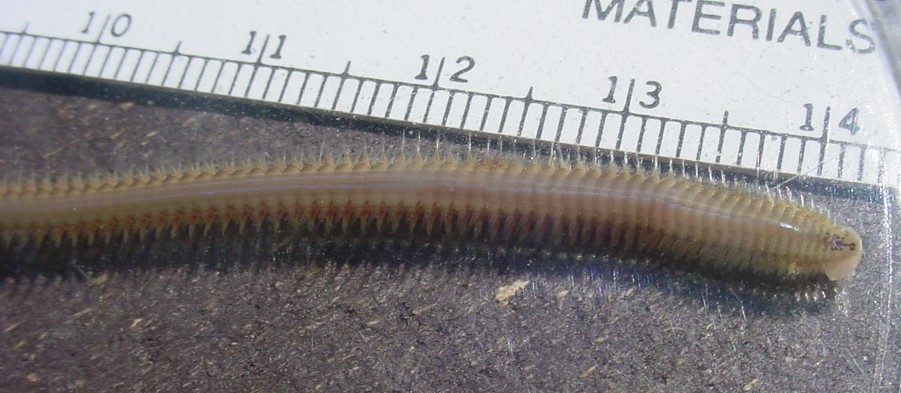Nephtys ferruginea Hartman, 1940
Common name(s): Sandworm

Class Polychaeta
Order Phyllodocida
Superfamily Nephtyidacea
Family Nephtyidae
Nephtys ferruginea Hartman, 1940Common name(s): Sandworm |
|
| Synonyms: |  |
| Phylum Annelida
Class Polychaeta Order Phyllodocida Superfamily Nephtyidacea Family Nephtyidae |
|
| Nephtys ferruginea from Guemes Channel, Anacortes, WA. Total length about 7 cm. Proboscis is partly everted (on right) | |
| (Photo by: Dave Cowles, July 2005) | |
How to Distinguish from Similar Species: No other Nephytid has the dark longitudinal lines on both sides of the midline. Nephtys look similar to Nereis but have a different type of eversible proboscis and no long tentacles in the head region.
Note (2017): Leslie Harris (personal communication), a polychaete specialist from the Los Angeles Museum of Natural History, advises that this individual may actually be N. caecoides. N. caecoides has a pronounced pattern of head pigment as appears to be the case above, while N. ferruginea does not. N. caecoides also has interramal cirri markedly curved, forming a C or circle-shape, while N. ferruginea does not.)
Geographical Range:
Depth Range: Subtidal, 16-450 m.
Habitat: Sandworms burrow in sand or sandy mud
Biology/Natural History: Little has been written about this individual species. Sandworms (genus Nephtys) vary in color, and are often iridescent. They are usually predators, with an eversible proboscis. They are mostly active at night, and often may be found swimming then, in a sinusoidal motion. They burrow by everting their large proboscis, then withdrawing it and walking ahead into the space that opened up. They lack circular muscles so must evert the proboscis by contracting the longitudinal and perhaps dorsoventral muscles. They have unique, small spiral gills in the space between the notopodium and neuropodium on the parapodium. When burrowing the parapodia fold flat back against the body and the setae form a screen to keep particles out of the space around the gills. Strong cilia near the gills create a swift water current flowing backward along the body when burrowing. The genus has 4 small ocelli but they are invisible from the outside. The blood contains hemoglobin (free in the plasma)
Although worms from genus Nereis (in Family
Nereidae) and genus Nephtys (in Family
Nephtyidae) look similar to one another, they are definitely different.
One difference can be seen in the way they swim. Nephtys worms
undulate their bodies only slightly while swimming and produce a strong
forward propulsion by means of their parapodia,
resulting in efficient forward swimming. Nereis worms, on
the other hand, undulate their bodies strongly back and forth while swimming,
similar to what they do while crawling but in a larger, metachronous wave
which proceeds from the back to the front (retrograde). This wave
produces backward thrust which largely counteracts the forward thrust generated
by the paddling parapodia,
resulting in the worm mostly thrashing around rather than swimming efficiently
forward.
| Return to: | |||
| Main Page | Alphabetic Index | Systematic Index | Glossary |
General References:
Morris
et al., 1980
Sept,
1999
Scientific Articles:
Web sites:
